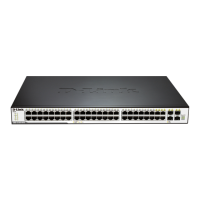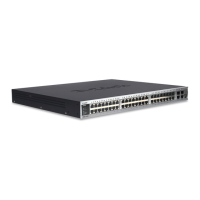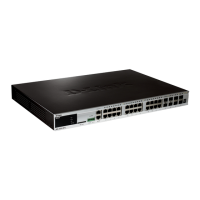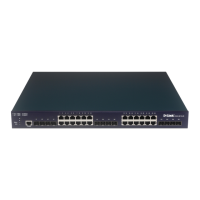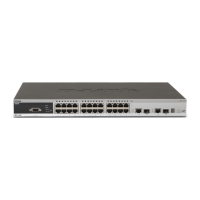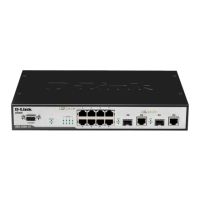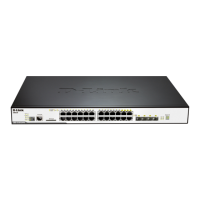xStack® DGS-3120 Series Layer 3 Managed Gigabit Ethernet Switch Web UI Reference Guide
103
The fields that can be configured are described below:
Parameter Description
Use the radio button to globally enable or disable STP.
Click to enable or disable sending new root traps.
Click to enable or disable sending topology change traps.
STP Version
Use the drop-down menu to choose the desired version of STP:
STP - Select this parameter to set the Spanning Tree Protocol (STP) globally on
the switch.
RSTP - Select this parameter to set the Rapid Spanning Tree Protocol (RSTP)
globally on the Switch.
MSTP - Select this parameter to set the Multiple Spanning Tree Protocol (MSTP)
Forwarding BPDU This field can be Enabled or Disabled. When Enabled, it allows the forwarding of
STP BPDU packets from other network devices. The default is Disabled.
Bridge Max Age (6-40)
The Max Age may be set to ensure that old information does not endlessly circulate
through redundant paths in the network, preventing the effective propagation of the
new information. Set by the Root Bridge, this value will aid in determining that the
Switch has spanning tree configuration values consistent with other devices on the
bridged LAN. The user may choose a time between 6 and 40 seconds. The default
Bridge Hello Time (1-2) The Hello Time can be set from 1 to 2 seconds. This is the interval between two
transmissions of BPDU packets sent by the Root Bridge to tell all other switches
that it is indeed the Root Bridge. This field will only appear here when STP or RSTP
is selected for the STP Version. For MSTP, the Hello Time must be set on a port
per port basis. The default is 2 seconds.
Bridge Forward Delay
(4-30)
The Forward Delay can be from 4 to 30 seconds. Any port on the Switch spends
this time in the listening state while moving from the blocking state to the forwarding
state. The default is 15 seconds
Tx Hold Count (1-10)
Used to set the maximum number of Hello packets transmitted per interval. The
count can be specified from 1 to 10. The default is 6.
Max Hops (6-40)
Used to set the number of hops between devices in a spanning tree region before
the BPDU (bridge protocol data unit) packet sent by the Switch will be discarded.
Each switch on the hop count will reduce the hop count by one until the value
reaches zero. The Switch will then discard the BDPU packet and the information
held for the port will age out. The user may set a hop count from 6 to 40. The
NNI BPDU Address
Used to determine the BPDU protocol address for STP in service provide site. It
can use 802.1d STP address, or 802.1ad service provider STP address.
Click the Apply button to accept the changes made for each individual section.
NOTE: The Bridge Hello Time cannot be longer than the Bridge Max Age. Otherwise, a configuration
error will occur. Observe the following formulas when setting the above parameters:
Bridge Max Age <= 2 x (Bridge Forward Delay - 1 second)
Bridge Max Age >= 2 x (Bridge Hello Time + 1 second)
STP Port Settings
STP can be set up on a port per port basis. It is advisable to define an STP Group to correspond to a VLAN group
of ports.
To view the following window, click L2 Features > Spanning Tree > STP Port Settings, as shown below:
